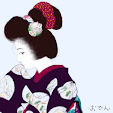
Today, I'd like to talk about Japanese custom of year end and new year.
Year end and new year are called "Nenmatsu Nenshi" in Japanese.
Though some customs are fading away, we have a lot of things to do during Nenmatsu Nenshi.
And today, Christmas is included as the one of year end events.
Most of events are originally held to welcome "Toshigami".
Toshigami is a god of Shinto that symbolize the year, and it visit each house every New Year.
(The photo is Maiko's first working day of the year.)
● Shogatsu Koto-hajime
Beginning of preparing for New Year.
The date is 13th Dec.. But at east Japan, it begin at 8th Dec..
After this day, people send a year-end present called "O-seibo" as a token of gratitude.
And, preparing for new year's decorations, mainly Shimenawa (sacred straw rope), Kadomatsu (pine branche) and Kagamimochi.
All of them shouldn't adorn at 29th or 31th Dec..
At the last days of the year, homemakers make Osechi Ryori (special dishes for New Year), families make Mochi (rice cake) and do O-soji (cleaning up whole house).
Mochi too shouldn't be made at 29th or 31th Dec..
● Shimenawa (sacred straw rope)
It's also called "Shimekazari", and is decorated at Shrine, front door of house, a household Shinto altar and so on.
Meaning borderline of a holy zone and our world, and removing ill luck.
It's a mark and guide to help "Toshigami" visit there.
(Photo : Famous huge Shimenawa of Izumo Taisha Shrine.)

● Kadomatsu (pine branche)
It's also called "Matsukazari", and is made of pine, bamboo and so on, and be decorated at a gate.
It's a mark and guide to help "Toshigami" visit there.
(Photo : Gorgeous kadomatsu.)

● Kagamimochi & Mochi (rice cake)
Making Mochi for New Year cooking and Kagamimochi.
Kagamimochi is a kind of Mochi that is large and round and offered to "Toshigami".
Large Mochi, small Mochi and an orange are piled up and are decorated with Hoshigaki (dried persimmon), dried cuttlefish, sea tangle and so on.
But recently, most families buy them at a supermarket.
(Photo : Kagamimochi.)
(Movie : High speed making of Mochi by champion. Another video at Google Video.)

● Omisoka (the last day of the year)
It's also called "Otsugomori", and New Year's Eve is called "Joya".
At this night, people eat Toshikoshi Soba (buckwheat noodles eaten on New Year's Eve), and temple bells are tolled.
● Toshikoshi Soba (buckwheat noodles)
Buckwheat noodles that is eaten on New Year's Eve.
It's also called "Misoka Soba", "Otoshi Soba", "Tsugomori Soba" and so on.
You must eat up it before new year begin.
And if you leave it half eaten, you'll have no luck with money during the next year.
(Photo : Basic Toshikoshi Soba)

● Joya no Kane
Tolling of temple bells 108 times on New Year's Eve.
It's begun a little before midnight, and the last one strike is on New Year's Day.
Generally speaking, "108" means number of desire for worldly things called "Bon-no".
As tolling a bell, people renounce their worldly desires.
(Photo : Temple bell.)
(Movie : Famous "Joya no Kane" of Chion-in Temple at Kyoto.)

It continue to Omisoka and Shogatsu (How Japanese Greet the New Year, 2/2).


No comments:
Post a Comment